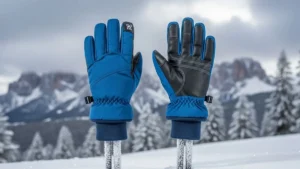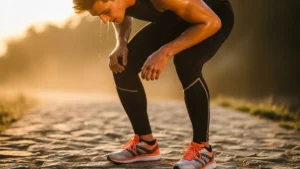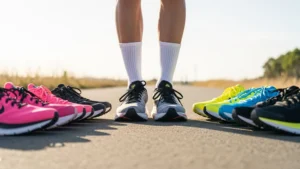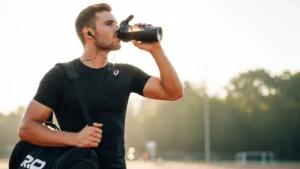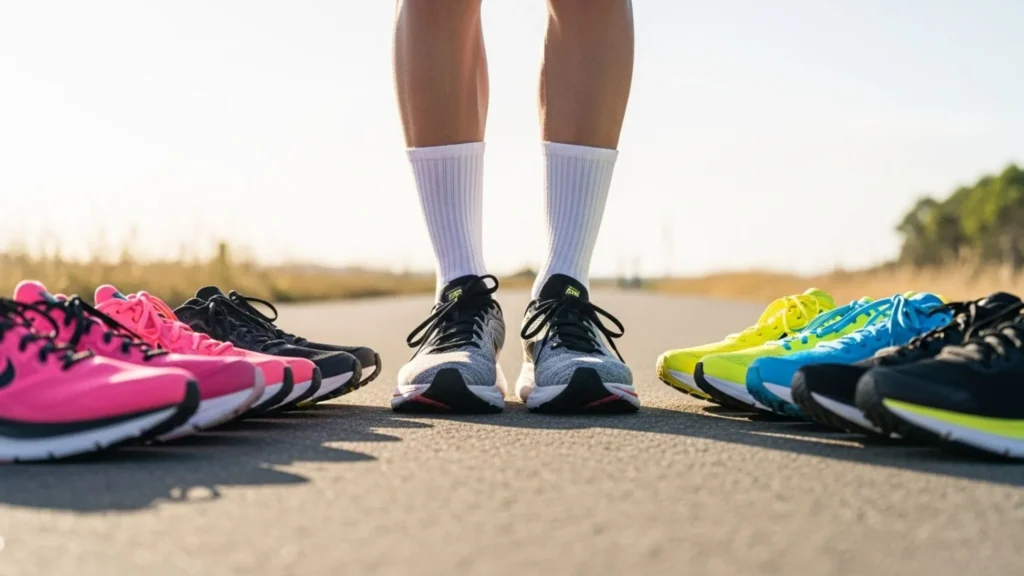
Real Questions Runners Ask Before Buying
Before buying a pair of cross country running shoes, most runners want quick, straight answers. I’ve gathered the most common questions real runners ask online and in stores. These are the facts you should know before spending a single dollar.
What makes a shoe best for cross country running?
The best shoe for cross country running is one that grips in wet and dry terrain, feels light on your feet, and supports natural movement. A solid balance of traction, cushioning, and flexibility keeps you fast and steady across unpredictable trails. Cross country routes don’t follow smooth tracks. You’ll face mud, grass, gravel, and sometimes steep climbs. A top-performing shoe handles all that without slipping or feeling heavy. Brands like Nike and New Balance design their XC models with aggressive lugs that dig into the ground for grip.
Are trail shoes good for cross country races?
Trail shoes can work for cross country races if the terrain is rocky or uneven, but they’re heavier and less responsive than true XC spikes or flats. For competitive racing, dedicated cross country shoes perform better. Trail shoes protect the foot from sharp rocks and roots but trade off speed. Cross country spikes focus on speed and grip over softer ground like mud and grass. If you race on mixed terrain, some runners use hybrid models that mix both designs.
How do I know my perfect fit?
The perfect fit in a cross country shoe leaves a thumb’s width of space in front of your toes, holds your heel securely, and hugs your midfoot without pressure. If your foot slides, the shoe’s too big. If your toes hit the front, it’s too small. Try them on with the same socks you’ll race in. Walk, jog, and check how they feel on uneven ground. Some runners prefer a snug fit for speed, while others want slightly more room for comfort. A good fit prevents blisters and wasted energy.
Do cross country shoes need spikes?
Most cross country shoes have removable spikes to improve traction on grass, mud, or dirt. Races on soft ground benefit from spikes, while firmer surfaces can be handled with rubber-soled flats. Spikes help dig into soft surfaces, preventing slips during sharp turns or uphill climbs. They also reduce wasted motion by keeping your stride efficient. However, for training or mixed terrain, runners often remove spikes and use the shoes as flats.
How long do cross country shoes last?
Cross country shoes typically last 250 to 350 miles before traction fades or cushioning breaks down. Runners who train often may replace them every season. The outsole wears fast due to abrasive surfaces and weather. If you feel your grip slipping or the midsole going flat, it’s time for a new pair. Using one pair for races only and another for training helps extend lifespan.
Quick Answer: The Top Cross Country Running Shoes in 2025
Finding the best shoe in 2025 depends on how you run, where you run, and how much you train. Below are the top-performing cross country shoes tested for grip, comfort, and lifespan. Each one stands out for a specific reason that fits a different type of runner.
Best Overall: Nike ZoomX Dragonfly XC
The Nike ZoomX Dragonfly XC is the best overall cross country shoe for 2025. It’s ultra-light, responsive, and grips confidently on grass and dirt. Its ZoomX foam provides energy return without adding weight, making it a race-day favorite for elite and amateur runners.
Pros:
- Featherlight build improves stride speed.
- Outstanding traction on soft terrain.
- Excellent cushioning for longer races.
Cons:
- Premium price.
- Less durable on rocky terrain.
Best for Beginners: Saucony Kilkenny XC 9
The Saucony Kilkenny XC 9 is best for beginners thanks to its comfortable fit, lightweight feel, and reliable grip. It’s easy to break in, affordable, and performs well on both dry and muddy fields, making it a great entry point for new cross country runners.
Pros:
- Affordable without cutting quality.
- Great traction for training and racing.
- Breathable upper keeps feet cool.
Cons:
- Cushioning feels basic compared to premium models.
- May wear faster on rough trails.
Best Grip: New Balance XC Seven v4
The New Balance XC Seven v4 offers the best grip among 2025 cross country shoes. Its multi-directional spikes and flexible rubber outsole hold firm on mud, wet grass, and gravel, helping runners stay stable through tight corners and uneven routes.
Pros:
- Superior grip across wet terrain.
- Sturdy spike plate for power on climbs.
- Smooth transition between soft and hard ground.
Cons:
- Slightly heavier than top-tier race spikes.
- May feel stiff during the first few runs.
Best Lightweight Option: Adidas Adizero XC Sprint
The Adidas Adizero XC Sprint is the lightest shoe in its class. Built for speed, it combines a thin yet strong upper with a sharp-spike plate for instant ground response. It’s designed for runners who chase fast times on short to medium-distance races.
Pros:
- Extremely lightweight and fast.
- Excellent breathability.
- Smooth, low-to-ground feel.
Cons:
- Minimal cushioning for long runs.
- Less protection on rocky terrain.
Best Durability: Brooks Mach 19
The Brooks Mach 19 is the most durable cross country shoe of 2025. It withstands heavy mileage and rough surfaces while maintaining comfort and traction. Its solid construction and flexible spike plate make it reliable for both training and racing.
Pros:
- Built to last through long seasons.
- Consistent grip on multiple terrains.
- Comfortable fit for high-mileage runners.
Cons:
- Slightly heavier than minimalist spikes.
- Requires break-in period.
Best Budget Pick: Asics Hyper XC 2
The Asics Hyper XC 2 is the best budget pick in 2025. It offers solid grip, decent cushioning, and a lightweight feel at a price that’s hard to beat. Ideal for students or runners who want reliable shoes without overspending.
Pros:
- Great value for the price.
- Balanced traction and comfort.
- Easy to clean and maintain.
Cons:
- Less responsive midsole.
- Limited color options.
How to Choose the Right Cross Country Running Shoe
Choosing the right shoe can change your race performance more than you think. It’s not just about brand names it’s about matching the shoe to your running surface, stride, and comfort. Let’s break down what truly matters before you buy.
Consider Terrain Type: Grass, Mud, or Gravel
The best shoe depends on where you run. Grass and mud need deep spikes for traction, while gravel or dry dirt runs better with rubber-soled flats. The terrain determines how much grip and protection your feet will need. Cross country races often mix surfaces, so versatility counts. Muddy courses favor long spikes (9mm–12mm), while firm courses do well with shorter ones (6mm). Gravel paths call for strong outsoles with less aggressive tread. Picking the wrong sole can mean slipping or wasting energy on soft ground.
Know the Difference Between Spikes and Flats
Spikes are designed for race-day grip on soft ground, while flats work better for dry, compact surfaces and training runs. Spikes help you dig into mud and grass, but flats give smoother transitions on firm paths. Spikes often come with removable pins for adjusting traction. Flats, on the other hand, rely on patterned rubber outsoles for grip. Runners who switch between them usually keep both types in rotation. A quick rule: use spikes for competition and flats for training or dry races.
Match the Shoe to Your Running Style
Your running style decides the shoe’s flexibility and support. If you’re a forefoot striker, choose a flexible spike plate. Heel strikers do better with extra midsole cushioning for shock absorption. The right match keeps your stride efficient and reduces injury risk. Neutral runners can use lightweight spikes for speed, while those with pronation may prefer slightly supportive flats. Some brands like Brooks and Saucony design models that adapt to both. Always test-run before racing comfort in motion tells more than specs on paper.
Check Fit and Comfort First
A proper fit means no slipping, pinching, or heel lift. The shoe should feel snug in the midfoot with a thumb’s width of space at the toes. Uncomfortable shoes can turn a 5K race into pure misery. Try them on with the socks you plan to race in. Your foot swells slightly during runs, so a tight fit becomes painful fast. Walk, jog, and twist your foot if anything rubs or feels loose, it’s not the right pair.
Weight and Cushioning Matter
Lighter shoes increase speed but reduce shock absorption. Heavier shoes cushion better but can slow you down. Finding the balance between speed and comfort depends on your race distance and terrain. For short, fast races, pick shoes under 6 ounces. For longer distances or rougher trails, go with slightly heavier shoes that offer protection. Cushioning also affects fatigue less impact means more energy for the finish.
Durability and Weather Resistance Count
Durable shoes save money in the long run. Cross country races often involve rain, mud, and rough ground, so water-resistant materials and reinforced stitching keep your shoes lasting longer. Look for ripstop uppers or coated mesh that shed moisture easily. Outsoles made from carbon rubber resist wear better than blown rubber. Shoes like the Brooks Mach 19 and Nike ZoomX Dragonfly XC are known for staying intact through multiple seasons.
What Runners Loved About 2025 Models
Runners praised the 2025 models for better traction, improved fit, and lighter feel. Many noticed that newer materials dried faster after muddy runs and didn’t tear as easily. The biggest wins came from comfort and grip the two things that define a good cross country shoe. Racers appreciated that brands like Nike, Saucony, and New Balance focused on stability without making shoes bulky.
Spikes felt sharper but not painful underfoot, even on longer runs. The updated mesh uppers also kept shoes breathable and odor-free after multiple uses. Reviews from training clubs often mentioned less post-run fatigue and fewer blisters, showing that brands finally listened to long-standing complaints about rough interiors. Shoes like the Brooks Mach 19 and Saucony Kilkenny XC 9 earned the most consistent five-star ratings.
Common Complaints to Watch Out For
Even the best shoes have flaws. Runners reported issues with sizing differences between brands, thin cushioning on lightweight models, and spike plates wearing out faster than expected. Some also mentioned that certain designs trapped mud more easily, adding unwanted weight mid-race. Nike’s Dragonfly XC, while fast, received comments about delicate uppers tearing under rocky terrain.
Adidas models ran narrower, causing toe discomfort for wide-foot runners. Budget shoes like the Asics Hyper XC 2 lost traction sooner but still held up well for the price. Many runners pointed out that shoes claiming to be “waterproof” only resisted light moisture. Once soaked, they took longer to dry, which caused blistering during back-to-back races. These points are worth noting before you buy based on hype alone.
Data Worth Knowing
Data from shoe testing labs and user surveys in 2025 shows that most cross country shoes last between 250–350 miles, with average satisfaction ratings around 8.6 out of 10. Return rates dropped by 12% from 2024 due to better sizing consistency and improved materials. Durability leaders include Brooks and New Balance, both crossing the 400-mile mark before grip decline.
Nike and Adidas scored highest for performance feel but lower on long-term wear. Saucony earned high marks for comfort, while Asics stood out for affordability. In surveys, 78% of runners said their shoes performed exactly as advertised, showing that the 2025 models delivered stronger reliability overall. These stats prove that design upgrades this year weren’t just for looks they genuinely helped runners finish faster and with fewer problems.
Cross Country Shoe Maintenance Tips
Keeping your cross country shoes in shape is the difference between consistent performance and early replacement. Proper cleaning, drying, and storage protect traction, fit, and comfort. Here’s how to make your 2025 running shoes last longer and perform better every season.
Cleaning After Muddy Runs
Clean your shoes immediately after muddy runs to prevent odor, stiffness, and sole damage. Mud and debris clog spikes, reducing traction and airflow. Quick cleaning keeps your shoes light, flexible, and race-ready. Rinse shoes under lukewarm water using a soft brush or old toothbrush. Avoid high-pressure hoses that loosen glue or spike plates. Remove insoles and laces before cleaning they dry faster separately.
For stubborn mud, let it dry slightly, then brush it off instead of scrubbing wet dirt deeper into the fabric. Never throw your cross country shoes in a washing machine it weakens adhesives and damages mesh uppers. A five-minute hand clean after each run adds weeks to their lifespan.
Drying Without Damaging
Never use direct heat. Let your cross country shoes air-dry naturally at room temperature. Heat from dryers, radiators, or sunlight can warp midsoles, melt adhesives, and shrink fabric. Stuff your shoes with newspaper or paper towels to absorb moisture quickly. Replace the paper every few hours until dry.
If you need faster results, place shoes near a fan not on top of it. Avoid leaving damp shoes in a closed bag or car trunk overnight; that traps humidity and leads to bacterial buildup. Proper drying keeps your shoes odor-free and comfortable for your next run.
How to Extend Lifespan
Rotate your cross country shoes with a backup pair to reduce wear. Using one pair for every session compresses foam faster and wears spikes unevenly. Rotation helps midsoles recover and keeps traction consistent longer. Clean your shoes regularly, store them in a cool, dry space, and avoid using them on concrete or asphalt surfaces they’re designed for grass, gravel, and mud, not hard roads. Check spike plates after every few races. Replace missing or rusted spikes before the next run to prevent imbalance and slipping. A small maintenance kit can add months of life to your shoes.
When It’s Time to Replace Them
Most cross country shoes last between 250–350 miles. Replace them when you notice reduced grip, uneven tread wear, or midsole flattening. Pushing beyond their lifespan risks injury and poor traction in races. If you feel new aches in your ankles or knees, your shoes may have lost cushioning or alignment support.
Another sign is discomfort after short runs something fresh shoes immediately fix. For spike shoes, check if metal tips have dulled or bent. For flats, inspect tread edges; once smooth, traction drops sharply. Timely replacement ensures consistent performance and safety.
Final Thought
Choosing the right cross country running shoe isn’t about chasing trends it’s about matching your stride, terrain, and goals. Every 2025 model brings something specific to the track, but the best one is the pair that fits your needs and keeps you confident mile after mile.
Here’s a quick summary of the best 2025 picks by category:
- Lightweight: Adidas Adizero XC Sprint built for pure speed and minimal drag. Ideal for runners chasing podium finishes on short, firm courses.
- Durable: Brooks Mach 19 strong outsole grip and long-lasting spike plates that hold up through a full season of training and competition.
- Budget-Friendly: Asics Hyper XC 2 affordable, comfortable, and dependable enough for school races and practice sessions.
- Performance All-Rounder: Nike ZoomX Dragonfly XC unmatched energy return and grip, suited for elite runners tackling unpredictable terrain.
Each shoe serves a different type of runner some prioritize speed, others durability. Knowing where you run most often helps you pick the right model without overspending or compromising comfort.
FAQs
Can I use cross country shoes on road runs?
No, cross country shoes aren’t built for road use. Their spikes or aggressive soles can wear down fast on asphalt, reducing grip and comfort. They’re made for soft terrain grass, mud, or gravel where traction and flexibility matter most. Running on hard roads with cross country shoes also increases pressure on your joints since they lack the cushioning of road trainers. If you often mix terrains, consider a hybrid trail shoe that can handle both surfaces safely and comfortably.
What’s better spikes or rubber soles?
Spikes offer superior traction on grass and mud, while rubber soles perform better on firm or mixed terrain. The choice depends entirely on where you race and train. Spiked shoes grip soft ground, preventing slips during sharp turns and sprints. However, they’re not ideal for rocky or hard-packed trails. Rubber-soled flats give more comfort and versatility best for runners training across different surfaces or those new to cross country racing.
Are cross country shoes waterproof?
Most cross country shoes aren’t fully waterproof. They’re designed to drain water and dry fast rather than seal it out completely. Lightweight, breathable uppers help release moisture instead of trapping it. Waterproof materials add weight and limit flexibility, which can slow runners down on wet courses. If you race in consistently muddy or rainy regions, consider models with water-resistant coatings or quick-dry mesh that keeps your feet light even when soaked.
Should I size up for cross country shoes?
You usually don’t need to size up for cross country shoes. They should fit snugly but not tight, with about a thumb’s width of space at the toe box for foot swelling during runs. A secure fit prevents blisters and slipping on uneven ground. Always try shoes with your running socks, as thicker socks can change the fit slightly. If you switch between brands, check sizing charts some, like Adidas, run narrower than others such as Brooks or Saucony.
Can cross country shoes help improve performance?
Yes, a proper pair can boost performance by improving traction, stability, and energy efficiency. The right shoe reduces wasted motion and helps you maintain pace on uneven terrain.
For example: lightweight spikes like the Nike ZoomX Dragonfly XC allow faster acceleration, while cushioned models like the Saucony Kilkenny XC 9 help with endurance. The best shoe won’t make you faster alone, but it supports your natural stride so you can perform your best.



